Menu
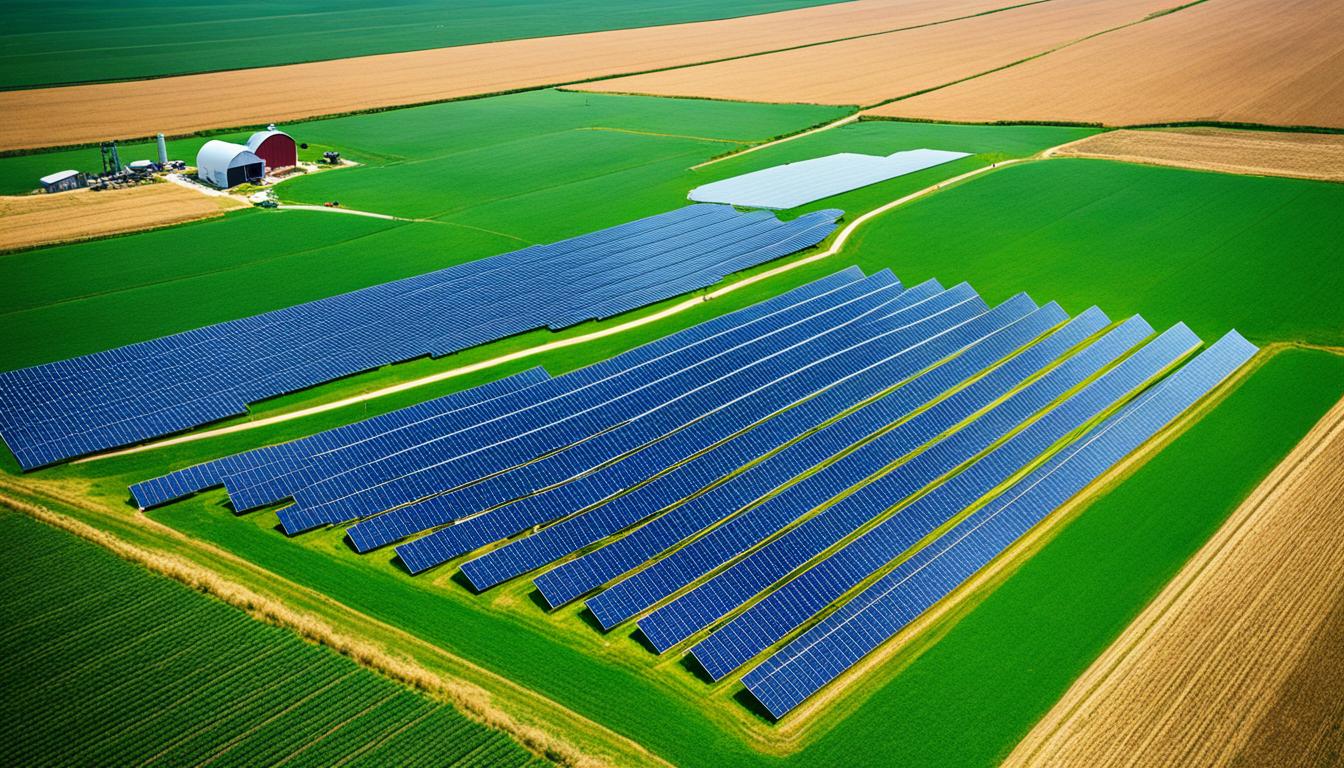
About one-third of our nation’s greenhouse gas emissions come from our food system. This makes it crucial to move towards sustainable food production. The journey to a sustainable food future faces many hurdles. These include using up our natural resources and the effects of climate change. The idea of ‘sustainability’ means creating things that can last. It’s very important now when we’re trying to find food solutions that are good for the earth and our health.
In today’s world, producing and delivering food should use as few resources as possible. Food processing is a key step in making our food supply sustainable. It has played a big role in making food safer and last longer. But now, we need to find new ways to make food that are good for people, the planet, and the economy. This is needed to keep the food industry going and to meet global goals for sustainability.
In 2019, Earth Overshoot Day was the earliest it’s ever been, on July 29. This day shows that we used up a whole year’s resources in just seven months. It’s a sign that we need to change how we produce food to protect our planet. Given that food production uses a lot of our planet’s resources, we must shift to greener ways of growing food. This change is not just good; it’s vital for our planet’s future.
Achieving sustainable food production is key for global growth, ensuring everyone has enough to eat. Our food supply must be sustainable, not just in how it’s made but also how it’s processed and prepared. These steps are often missed but are crucial.
There are big challenges in food science around the world. We need to come up with ways to make food that use less water and energy. Fanzo and others in 2022 discuss how important it is for our food to be made in a sustainable way.
It’s also really important to meet the goals set by The Natural Step and the UN. Supporting sustainable food industry growth includes tackling issues like food and water scarcity. It’s all about making sure the food we eat is good for us and the planet.
The link between our food and the environment is crucial. FAO in 2018 said that our food systems should be eco-friendly. Both what college students eat and what they know about food matter a lot when it comes to making sustainable choices. By looking at how to make our food systems sustainable, we learn a lot.
One big challenge is finding a balance between meeting food needs and not harming nature. Agriculture, like growing crops and raising animals, is a big source of greenhouse gases. It also covers a lot of land and uses most of the world’s freshwater. But there are approaches, such as the Marine Stewardship Council, that are working on making fishing more sustainable.
There’s also the issue of economic inequality affecting food systems. People with low incomes may not eat well, according to Bowman in 2007. However, younger generations, as shown by Bollani, Bonadonna, and Peira in 2019, care a lot about food systems being eco-friendly. They support practices that help the environment and ensure the food we eat is sustainable.
| Challenge | Sustainable Opportunity | Source |
|---|---|---|
| Greenhouse Gas Emissions | Sustainable Crop and Livestock Practices | FAO (2018) |
| Resource Depletion | Efficient Use of Natural Resources | European Strategy and Policy Analysis System |
| Economic Disparities | Certification and Fair Trade Practices | Bollani et al. (2019) |
To make food production more sustainable, we need to face big challenges. But we must also see the opportunities. This means looking at the whole food system and making changes that will help us all have enough to eat without harming the planet.
Technology greatly helps improve green farming. It does this through many tools and methods used by farmers. This includes things like using high-tech systems in farming and the latest in digital networking.
Precision farming is high-tech farming at its best. It uses a lot of smart tools and devices like sensors, flying drones, and data analysis. These things help farmers use water and fertilisers better, which is good for the planet.
Because of these methods, farms can produce more food using less land. In fact, if farms didn’t use these advanced ways, they would need an area as big as South and North America combined. This shows how important hi-tech farming is for nature.
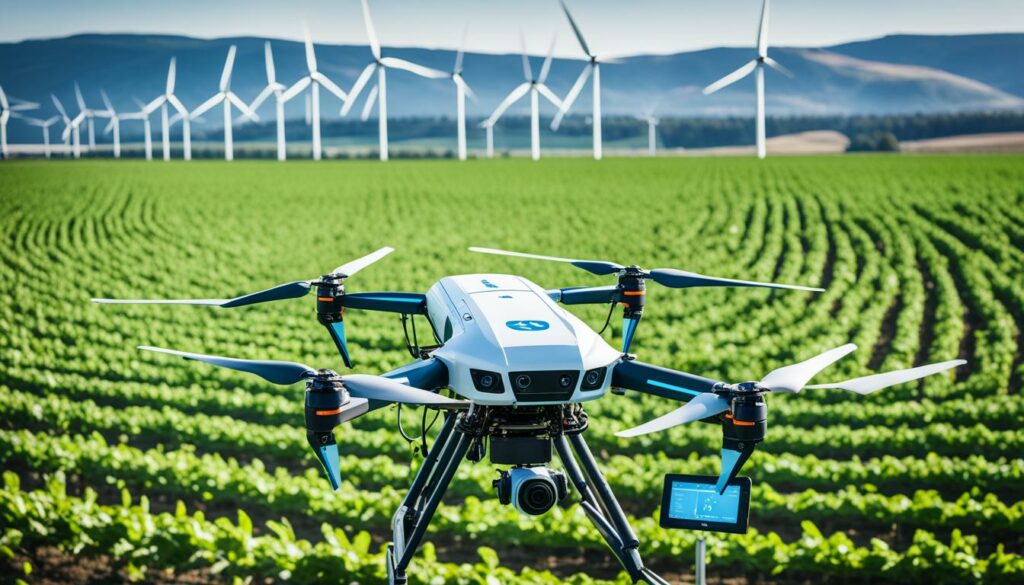
Blockchain is changing how food gets from the farm to our tables. It makes sure everyone knows where the food comes from and how it was made. This builds trust and supports fairness, which helps look after the Earth better.
With blockchain, we can check every step of how our food is made. This open way of tracking things ensures farming is done right. It matters more and more to people that their food is made in ways that are good for the environment.
By investing in these new tools, we can make farm systems better. They support making the Earth healthier and treat people fairly. It’s about making farming work well without harming the world. These steps are important for a future where farming is both wise and kind.
“The use of biological and chemical technology plays a crucial role in agriculture’s past, present, and future, emphasising the importance of preserving nonrenewable resources for sustainability.”
Using new technology in farming means we can meet needs today without damaging tomorrow. It’s about farming smartly to protect what we have for those who will come after us.
Organic farming leads the charge for a better environment. It aims to keep natural resources safe and boost the variety of life on the planet. Unlike usual farming, organic farms don’t use man-made pesticides and fertilisers.
Organic crops grow without changing their DNA or using fake stuff. This means less pollution and fewer harmful chemicals in our food. It is a huge step towards a farming future that lasts. But, even with these good points, worldwide farming plans find it hard to make room for organic farming. And this makes it tough to really know its big effect on our planet.
Now, here comes the tricky bit. Organic farms might not make as much food as other farms. So, they might need more space to grow the same amount of food. This could make feeding the world in a green way hard. If we aim for 100% organic farming, we may need more land, and more forests might have to be cut down. It’s something to really think about for our future.
To make things work, we should mix organic farming with other ways to get food. Eating less meat, wasting less food, and changing how we feed animals can be a big help. Putting different good ideas together, we can make enough food without hurting the planet. And this is key for feeding over 9 billion people well by 2050.
Walking the green farming path is not just about going organic. It’s about doing more. We need smart plans and everyone to work together. This way, we can farm in a way that’s good for the Earth and still feed those yet to come.
about how organic farming helps us move closer to a green future.
Vertical farming helps deal with food challenges and lessens the environmental harm of farming. It uses city spaces to grow more crops where there’s not much land. Technologies like hydroponics and aeroponics let farmers grow plants all year using less land and water.
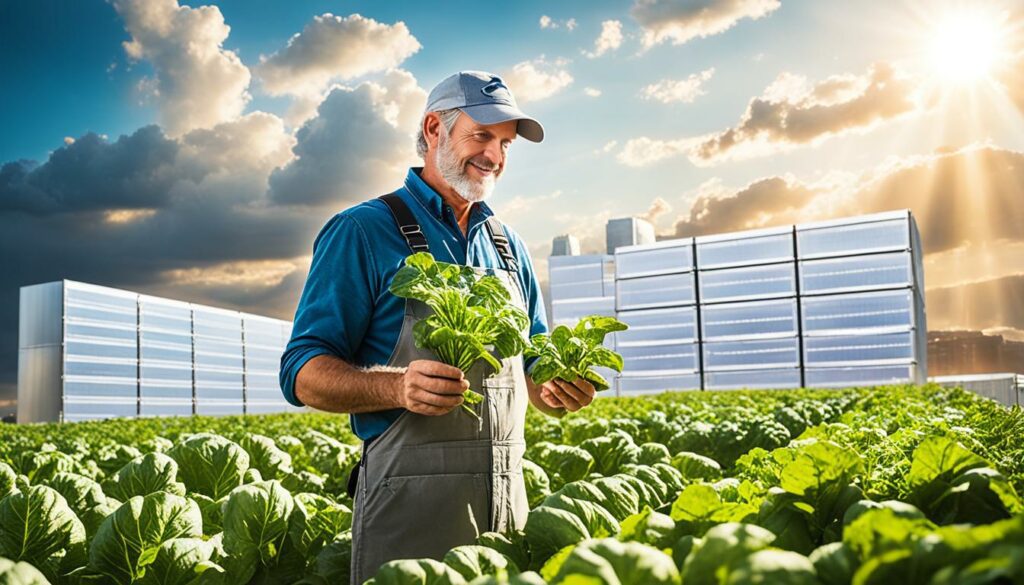
Both hydroponics and aeroponics play a key role in vertical farming.
Hydroponics grow plants without soil, just in nutrient-rich water. Aeroponics grows them in a mist without soil.
These methods save a lot of water and cut down on synthetic pesticides. They make urban farming more sustainable.
Vertical farming comes with various pluses.
It boosts food production, lowers carbon footprint, and cuts down on transport pollution.
Crops are grown near cities, so we import less, make more local jobs, and help the economy.
Examples like The Plant Chicago and The Sky Greens in Singapore show it works well.
Yet, there are downsides too.
It’s costly to start, and the running costs add up. Then, there’s the worry about using too much energy and how well it can grow really big.
People also talk about if it’s really good for the environment and if the food’s as nutritious. We need more study and new ideas to solve these issues and make sure it lasts.
Regenerative agriculture transforms farming by focusing on soil health and lowering environmental harm. It boosts soil quality, which improves the land’s ability to support life and grows food sustainably. This method restores soil power by encouraging diverse life and trapping carbon. These steps help fight off the harms done by traditional farming methods.
Boosting soil health is crucial in regenerative farming. The U.S. is losing soil 10 times faster than it grows back. By cutting down on ploughing, farmers can increase the soil’s organic matter. This makes the land healthier. It also helps pull 23 gigatons of carbon from the air, which fights climate change.
Experts from Project Drawdown see a bright future for regenerative farming. They predict it could cover a billion acres by 2050. With this growth, we could see an extra $1.4 trillion tonnes of crops. This shows just how beneficial regenerative farming is. But, spreading these methods faces challenges, such as a lack of farmer knowledge and funds.
Scientists warn that soil damage is a big threat. They say our actions are leading to dangerous carbon loss, erosion, and desert growth. But, techniques like planting cover crops and moving livestock around can help. These methods trap carbon and improve soil nutrients. Plus, they boost animal and plant diversity. This makes farms stronger and better prepared for tough times.
| Impact | Benefits of Regenerative Agriculture |
|---|---|
| Soil Health | Increases organic matter content, improves nutrient supply, reduces erosion |
| Environmental Impact | Reduces greenhouse gas emissions, removes CO2, mitigates climate change |
| Biodiversity | Enhances wildlife variation, supports ecosystem resilience |
| Crop Production | Strengthens food security, improves crop resilience to weather extremes |
Large farms are slowly falling into the hands of a few big companies. With the planet facing serious threats, there’s a urgent need for sustainable farming methods. Governments can help by giving farmers money incentives to go green. Actions like planting trees with crops and finding natural ways to control pests also help a lot. These steps protect wildlife and make the earth’s health better.
Ethical food sourcing is now key in the food and drink world. A Nielsen study found 55% of people globally would spend more on ethical products. This shows consumers care a lot about where their food comes from.
Fair trade certification builds trust with consumers. It shows that companies are sourcing responsibly and making things in a sustainable way. Over two-thirds of Americans think about the environment when they buy, and nearly half would pay extra for this.
Companies that don’t focus on sustainability in their food chain might lose customers. Today, people want to know their food has been made fairly and doesn’t harm the planet. It helps support farmers and their communities too.
Using ethically sourced ingredients can make food better. Nutrition bars, for example, taste and are healthier when they’re made from fair trade items. This not only makes the product better but can set a business apart from its rivals.
Supporting sustainability in getting food also helps protect our planet. In 2021, too much food waste led to a lot of pollution. But, efforts like Imperfect Foods helped save a lot of food, cutting waste and pollution.
Being ethical can be hard for businesses. It often means higher costs. Yet, paying fair wages and using sustainable methods is crucial. It supports communities, keeps workers safe, and ensures good food. Certifications like Fair Trade or Organic show a company is doing the right thing. It builds trust with customers.
Moving to ethical food isn’t just a phase. It shows a big change in how we think about the environment and society. Nowadays, consumers want to buy from companies that share their green and fair values. This is helping to build a future where we all live better.
Today, the move towards better food practices is very important. It needs us to change how we produce food and to think more about the planet when we eat. With more than three billion people not getting enough good food, we see that making our food systems better is not a choice – it’s a must. And, with almost 10 billion people expected by 2050, the need for food that keeps the planet and us healthy has never been so urgent.
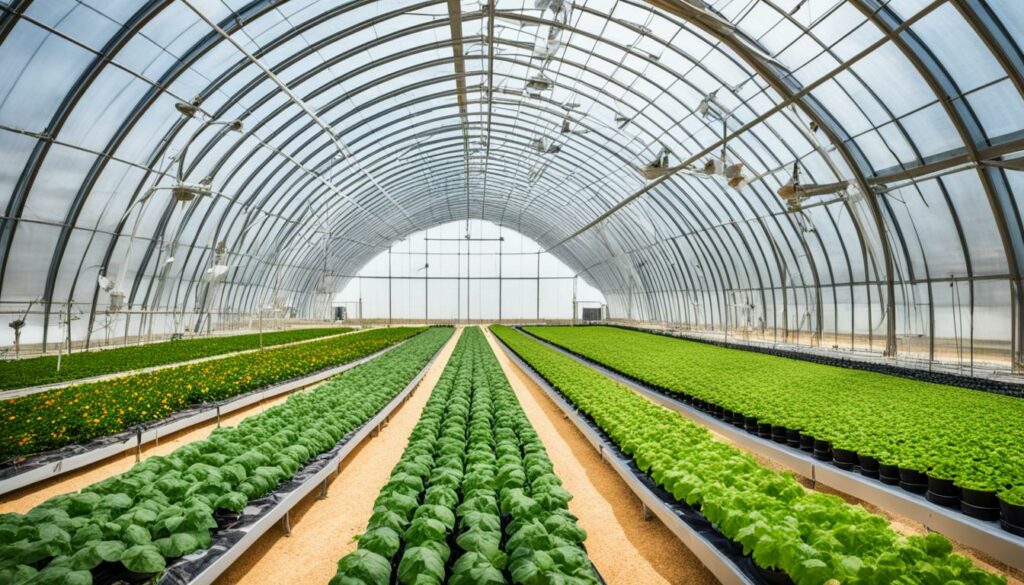
One key step is teaching people about the food that’s good for the planet. Right now, the way we make food creates a lot of the greenhouse gases in the world and uses a lot of the water. We need to look closely at not just what we eat, but how it got to our plates. This means moving to farming that uses fewer resources and eating more plant-based foods.
When people learn about how their food choices affect the planet, they can make better decisions. For example, choosing food that’s made and delivered with the planet in mind can cut down how much greenhouse gas we make. Small changes, like eating plant-based meals sometimes, can add up to big savings in emissions and water use.
Eating in a way that is sustainable not only helps the planet, but it’s also a healthier choice for us. It means eating less red meat and more foods like fruits, nuts, and vegetables. By knowing what’s good for the planet and demanding those things, we can lead the way to a better food future. This teamwork between smart shoppers, governments, and companies is vital if we’re to succeed in making our food system sustainable.
| Key Factors | Statistics | Implications |
|---|---|---|
| Global Malnutrition | 3 billion people | Critical need for nutritious food systems |
| Future Population | 10 billion by 2050 | Increased demand for sustainable food production |
| Greenhouse Gas Emissions | 30% from food production | Necessity to reduce carbon footprint in agriculture |
| Freshwater Usage | 70% used by agriculture | Efficiency and conservation are essential |
| Dietary Shift | 50% less red meat, double plant-based foods | Sustainable diet transitions as per EAT-Lancet |
Environmentally friendly crop cultivation is key to sustainable farming. With our planet’s population expected to hit 10 billion by 2050, the need for more food is huge. Growing food in a way that protects the Earth benefits us now and in the future.
Eco-friendly farming focuses on using resources wisely. It works to grow a lot of food without harming nature. This means using what’s around us well, not using too much water, and using natural fertilisers to keep the soil healthy.
More than a billion people around the world earn a living from farming. Sustainable farming helps feed us all by being smart and not hurting the land. Using things like changing what crops we grow each season keeps the soil strong. This means we get more food that’s better for us, without hurting the environment.
Agriculture that’s good for the land also helps fight climate change and makes sure we all have enough to eat. For example, Eden Green in Texas grows lots of food in a small space, using very little water. Their modern farming way makes five million pounds of fresh green food each year, while using much less water and land.
Sustainable farming isn’t just good for the planet. It helps communities by making things fairer, boosting local businesses, and helping farmers make more money. By looking after the Earth and how we grow food, we can have a better world for everyone.
Water shortage is a global issue, prompted largely by agriculture’s high freshwater usage. It’s crucial to find ways to save water and protect our dwindling sources. By adopting certain practices, farming can cut down on the amount of water it uses. This helps keep water resources available for the future.
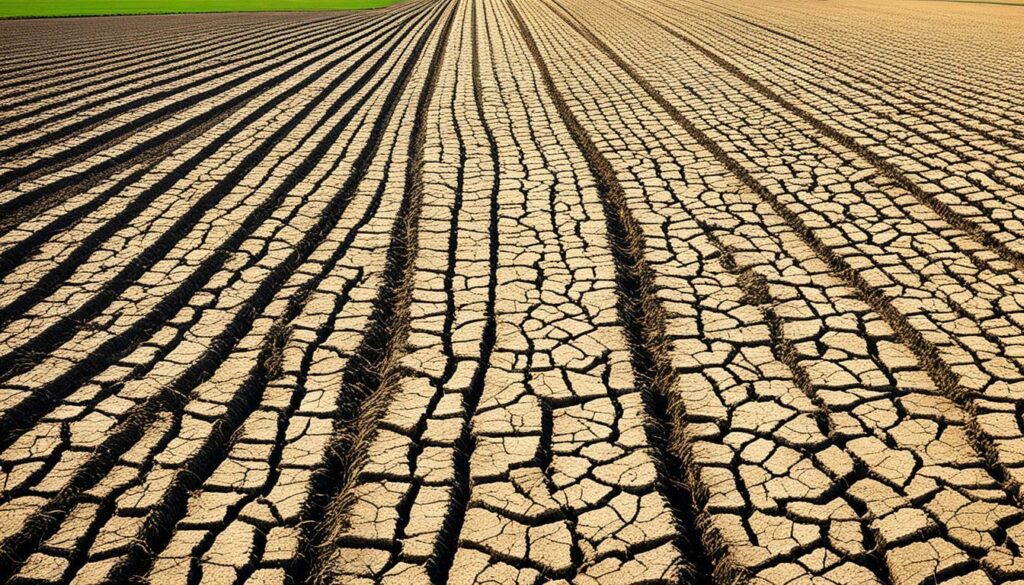
Using smart irrigation methods is key to saving water in farming. Drip systems, for example, stop water from evaporating and running off. They deliver water straight to plant roots. This is great for places that don’t get much rain.
Setting up a smart schedule for watering stops plants from getting too much water. It also keeps water from being wasted. Saving rainwater and adding compost and mulch to soil can lower water loss too.
| Method | Advantages |
|---|---|
| Drip Irrigation | Minimises evaporation, reduces runoff, and directs water to roots |
| Irrigation Scheduling | Prevents overwatering, ensures efficient water use |
| Rainwater Harvesting | Captures and stores water for later use |
| Mulching | Reduces soil evaporation, improves soil moisture |
Growing plants that don’t need as much water is key to saving water. These plants are specially chosen to survive with very little water. Through this method, companies such as Bayer CropScience lessen the use of water-hungry crops.
Switching up the types of plants grown and covering bare soil also saves water and makes the ground healthier. These changes help farmers use water better and avoid wasting it. Even with less water available, they can still grow plenty of food.
The world needs sustainable food systems more than ever. In 2022, about 9.2% of the global population faced chronic hunger. This is around 735 million people. These challenges in food security urge us to find new ways to produce food.
Unsustainable methods like excessive use of fresh water and producing too many greenhouse gases harm our planet. Agriculture uses 70% of the world’s fresh water and a quarter of global energy. To fight these problems, we aim for sustainable food systems.
Food system management is key to a sustainable supply chain. This includes farming, processing, and getting food to consumers. A well-managed supply chain produces more food, wastes fewer resources, and tackles food loss on a global scale. The USDA prioritises sustainable food chains. It aims to meet human needs while protecting the environment and ensuring economic success.
Using sustainable consumption is also crucial. Many rural people rely on small-scale farming, where poverty is common. Additionally, the excessive consumption in wealthier nations puts a strain on our planet. It’s said that if everyone lived like the rich, we’d need five Earths. So, promoting sustainable ways of using resources is essential. This ensures our food practices are fair and do not harm the planet.
We need everyone in the food system to work together sustainably, from farmers to shoppers. This strategy concurs with the FAO on what makes a food system sustainable. It must be profitable, benefit society broadly, and leave a good or at least neutral effect on the environment.
Even though it’s not simple, applying food system management can boost food chain sustainability. This, in turn, helps in the fight for global food security. Moving ahead, creating a responsible, linked, and clear food system is key to a lasting future.
Half the world’s farmable land is used for food production. This shows the need for protein sources that won’t harm the Earth. Switching to proteins from plants or insects could make a big difference. It might shrink the land we use for farming and lower the gases our food makes. These gases are much less from plant foods than from meat and dairy products.
Our food system is making too many emissions. These add to climate change. But by choosing plant or insect foods over meat, we can help a lot. It takes less water and land to grow plant-based foods, reducing the bad effects on water and fish. This mostly happens because of raising cows. But, we can change this by what we eat.
Going for more plants as our food can help a great deal. It lowers the greenhouse gases we make and saves land and water. Things like soy, lentils, and peas are full of good stuff. They are just as good for us as meat but kinder to the planet.
Eating insects can also be a big win for our planet. Right now, about 2 billion people do it, and it’s a smart choice. Raising bugs doesn’t need a lot of space or water. And it pollutes much less. Making bugs a normal food choice can ease the pressures our usual foods put on the environment.
There are other smart choices besides just meat and bugs. Some new proteins come from things like yeast or a mix of different plants and bugs. Making and selling these foods could mean more jobs and money for the world. Going for these options isn’t just a new fad. It’s key to making sure we have a healthy planet and enough food for the future.
The food industry makes a big impact on global greenhouse gas emissions. Therefore, finding new ways to produce food is key. These new ways can help us use less energy and make less waste, making food production more eco-friendly.
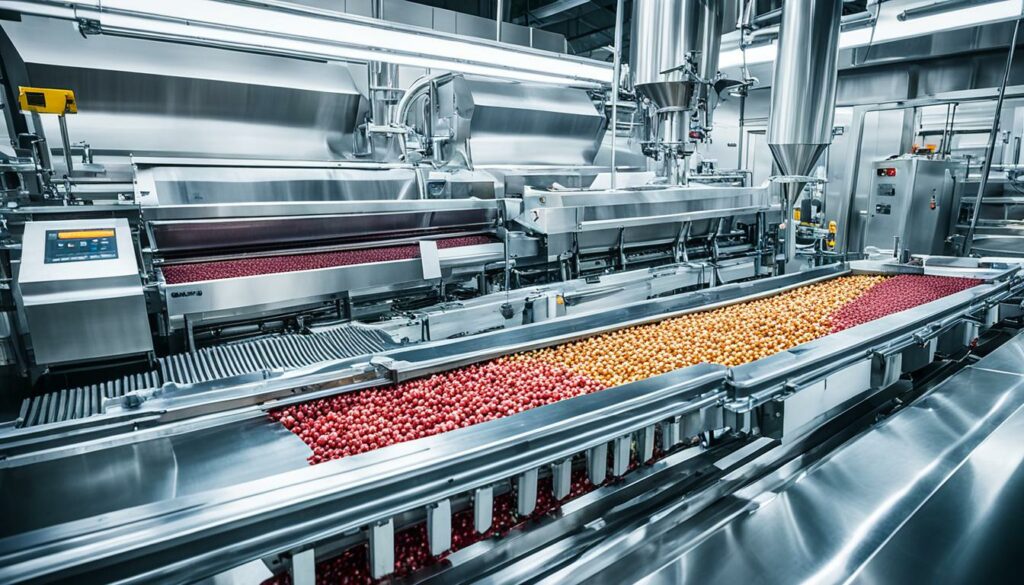
About 40% of food worldwide is thrown away. But, there are ways to change this. For example, high-pressure processing can keep food fresh for longer. This means we throw away less food.
It also turns out that the process of making food doesn’t create a lot of emissions. So, using these new methods can help the planet a lot.
Saving energy is crucial in making food. One study compared the carbon footprint of different foods. It showed we need to focus on how we make food to use less energy.
For example, fixing machines at a food factory in Europe saved a lot of energy. This means big savings for them every year. It also helps in our efforts to produce food in a way that’s good for the environment.
| Method | Benefits |
|---|---|
| High-pressure Processing | Extends shelf life, reduces food waste |
| Machine Optimisation | Saves energy, reduces operational costs |
| Life Cycle Assessments | Analyses emissions, improves sustainability metrics |
By using these new ways, the food industry is moving towards a greener future. These improvements in how we process food are vital. They help us use less, waste less, and save energy, all while reaching our big goal of a more sustainable world.
By 2050, the global population could reach almost ten billion. This will mean a 70% increase in food production is needed. To meet this challenge, adopting green food cultivation practices is crucial. It focuses on sustainable farming and efficient, eco-aware growing methods.
Sustainable farming helps protect the environment and boosts food production. By using local resources, less water, and natural fertilisers, farmers see big advantages. These green methods improve soil and water, while supporting small farmers economically.
Creating green food systems is key to protecting the planet and fighting climate change. Each step towards sustainable agriculture makes a big difference. It helps us secure a future where we can feed everyone without harming the environment.
“Nearly 18,000 papers examined the link between incentives and the adoption of sustainable agricultural practices, revealing that incentives play a crucial role in promoting these green practices.”
Moving towards green food cultivation is a big change. It recognises agriculture’s impact on our planet. Choosing these practices leads us to a future where growing food won’t harm nature.
I always feel inspired by the successes in sustainable food production. These cases range from U.S. wheat farms to global agriculture. They light the way for those looking to be more eco-friendly in food production.
U.S. wheat farming has made great progress in sustainability. In 2007, there were hundreds of millions of farmed acres in the U.S. Wheat fields used fewer resources but still yielded well. Despite corn and soybeans being the main crops, these farmers found ways to lower their environmental impact significantly.
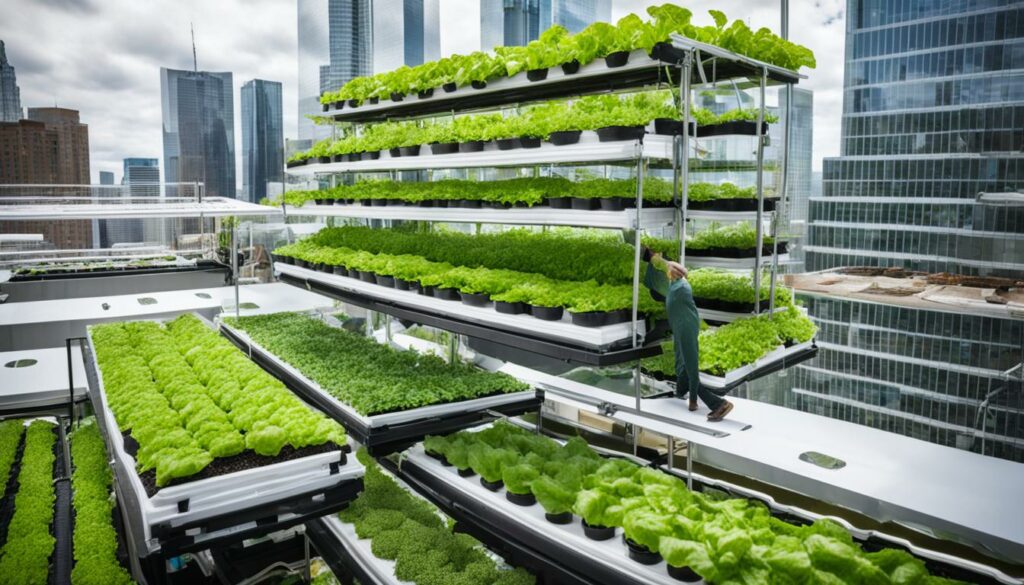
Did you know that 90% of what we spend on food is for processed food? Yet, U.S. food production grows about 1.74% each year for the last 50 years. But this growth has brought problems, like farmers getting less of the profit over the years.
Different parts of the world have shown success in sustainable agriculture. Denmark found a way to use less nitrogen, saving the environment without losing crop yields. In Kenya, using trees in farming not only improved farming but also helped fight climate change.
In Guatemala, small-scale coffee farmers improved their yields and income through sustainable projects. These case studies show that doing farming right can help both the Earth and the farmers’ pockets.
“Agricultural production needs to increase by at least 70% by 2050 to meet the growing demand for food,” according to the World Bank. This shows why it’s so important to farm in ways that don’t harm the planet.
Understanding and measuring sustainability in farming is crucial. It helps us find the best ways to grow food without harming the planet, people, and our economy. By looking at how well farms do in these areas, we can make better choices.
Key performance indicators, or KPIs, help us see how well farms protect the earth. They cover things like keeping the soil healthy, using water wisely, and cutting down on carbon emissions. Life Cycle Assessment (LCA) is key for checking these areas, offering a full look at how our food choices affect the planet.
Using these measures together in a plan helps make farming more sustainable. It’s a great system for always getting better and including everyone involved.
LCA is a top method for checking the environmental costs of farming. It studies everything from making the product to throwing it away. This tells us a lot about a product’s true impact on our planet.
Another helpful approach is SIS, which grades farming methods. This makes it easier to compare and improve how we farm. Also, talking to the local community and looking at how farming affects society can help see the bigger picture.
| Assessment Method | Focus Area | Application |
|---|---|---|
| Life Cycle Assessment (LCA) | Environmental | Measures the environmental impact of farming activities from cradle to grave. |
| Sustainability Indicator Scoring (SIS) | Comprehensive | Scores practices based on predefined sustainability criteria, supporting benchmarking efforts. |
| Socio-economic Evaluation | Social and Economic | Assesses impacts on community wellbeing, labour conditions, and economic viability. |
By using strong methods and indicators, agriculture can be a win for the planet, people, and profits. These methods are key for smart planning and to make sure our farms are in harmony with nature.
Through careful planning, government policies play a huge role in shaping sustainable farming. They are introducing changes that lessen harm to the environment. These steps also aim to make sure we can keep farming in a good way for the future.
In the U.S., how we take care of the environment and farm meets in laws and rules. It’s known that a big part of greenhouse gas emissions in the U.S. come from farming. To fix this, the government both federal and state worked to lower these harmful emissions.
These policies mean many farmers are now using methods that are better for the climate. For example, the government helps them out with money for growing crops. This has encouraged farmers to reduce the damage they do to the environment.
Earthjustice is a group doing a lot to help here. They push for more research and support to make farming kinder to nature. By using the law to help farmers, Earthjustice is making sure U.S. farming is moving in the right direction.
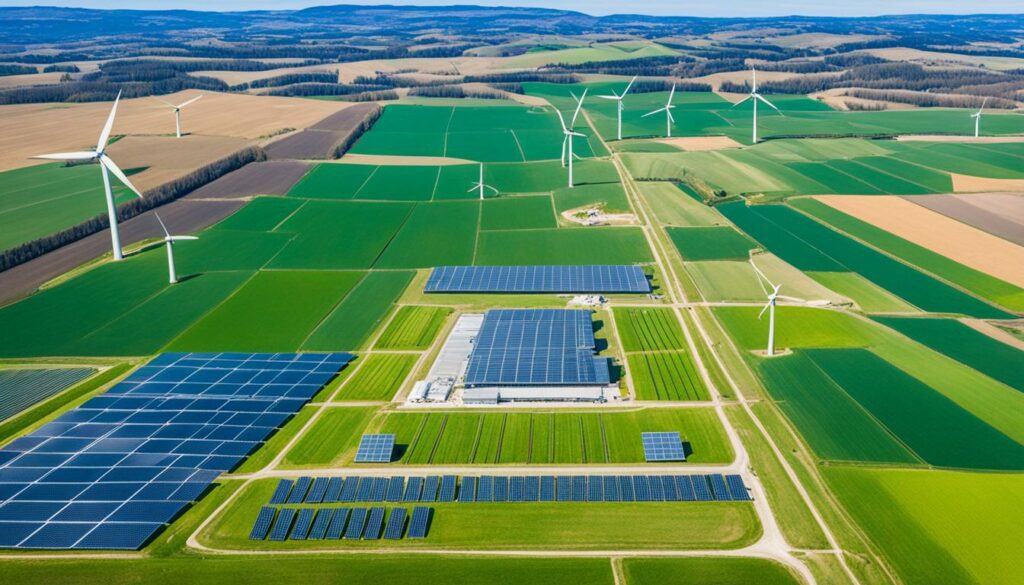
Worldwide, groups like the Food and Agriculture Organization help countries make good food policies. Their main goal is to make food farming better for people, the planet, and communities such as villages. They want food to keep coming without harming the earth.
The FAO tells countries about new farm methods that are good for food and the environment. They focus on fair farming, making sure everyone gets healthy food. Their attention is also on making sure farming doesn’t leave anyone out and that it’s better for women.
World leaders are asked to use these new farming methods to stop hunger and make sure everyone has enough to eat. They should support plans that are based on what really works. Having enough money from both inside and outside the country is key to moving their farming goals forward.
Europe, through its Farm to Fork plan, also aims to farm better. They want to reach food goals without making the planet suffer. Their rules help farms keep their impact low, stop cutting global forests, and work together to keep food safe and healthy.
The next table shows how different places are working on better farming:
| Region | Initiative | Focus | Impact |
|---|---|---|---|
| United States | Earthjustice Advocacy | Legal reforms and incentives for climate-friendly practices | Reduction in greenhouse gas emissions |
| European Union | Farm to Fork Strategy | Environmental impact, food security, and fair returns | Enhanced sustainable food systems |
| Global (via FAO) | SFA Policies | Resource efficiency, resilient livelihoods | Progress toward Sustainable Development Goal 2 |
Using renewable energy in farming is vital for our planet. It helps farmers lessen their use of fossil fuels. It brings new ways to grow food better, keeping the land safe. And it is good for the environment.
Solar power is great for warming up buildings and water on farms. It’s a clean way to make farms run better. Also, wind energy is growing fast and helping farms be more efficient. Many farmers in the U.S. turn to wind and solar to save money and earn extra cash.
Using renewable energy saves money and is better for the earth. For example, Roger Rainville from Vermont makes biodiesel for less than $2 a gallon. This cuts his costs and raises his profits. Making biofuels from plants shows there are many ways to power farms without hurting the planet.
Future looks bright for solar and wind in farming. New tech makes it easier to use these energies. This means farms can be more independent and make more money. The future of farming with these clean energies is about being strong and friendly to nature.
| Category | Details |
|---|---|
| Renewable Energy Sources | Wind, Solar, Biofuel, Anaerobic Digestion |
| Benefits | Cost Reduction, Profitability, Emission Reduction, Energy Independence |
| Future Prospects | Enhanced Sustainability, Technological Advancements, Diverse Energy Mix |
Our journey to eco-friendly food systems is complex yet vital. Sustainable food production relies on tech, policy, ethical sourcing, and saving water. These elements improve how we grow food, keeping it in harmony with nature.
It’s key to face challenges like using too much fossil fuel and harming the Earth by deforestation. Agroforestry shows promise, using trees like oil palm and rubber to diversify farming. This can help the environment and slow climate change.
Reducing the energy used in making food is also crucial. Right now, the food industry uses a lot of energy. Moving to renewable sources and better food making ways can help. This way, we build a food system that works well now and for the future.
Everyone’s effort plays a big part in the future of our food. Working together, we can have a food system that is strong, fair, and safe for the planet.
Sustainable food production means farming in ways that are good for the planet, don’t cost too much, and help people. It’s about making enough food now and in the future without hurting the earth a lot or wasting resources.
Being sustainable in making food helps deal with tough problems like the changing climate, less natural resources, and making sure there’s enough food for all. It also means we can eat well today without spoiling things for tomorrow.
Technology plays a big role in making farming kinder to the planet. Things like smart sensors and flying drones help use water and fertilisers better. They cut waste. Technology also helps by making sure the food you eat is sourced in a fair and clear way.
Organic farming is good because it doesn’t use man-made chemicals. It keeps the soil and plants healthy while looking after the wildlife. By using fewer artificial products, it also takes care of the earth. This is good for our future.
Vertical farming is great because it needs less space and is good for the planet. But, it costs a lot to set up and uses a big amount of energy. This makes some people wonder if it can be a long-term or green solution.
Regenerative farming is a way of farming that makes the land better. It focusses on putting more goodness back into the soil and not harming the environment. By doing this, it helps to keep our food sources secure and healthy for everyone.
Buying food from ethical sources means people and the planet are treated fairly. It supports good trade ethics and helps customers trust what they buy. This means better food for all in a way that doesn’t harm others or our home.
Teaching people about the impact of their food choices helps make better demands. Informed buyers can influence how food is made. This can push companies to do more for the planet and for ethical business.
Planting crops in ways that don’t harm the earth are good for everyone. It saves water, keeps the soil healthy, and protects animal and plant life. These careful and sustainable ways of farming are vital for a greener world.
Using methods like drip irrigation helps save water by aiming it straight at plants. Growing crops that need less water is also important. It helps us deal with the growing problem of not having enough water for farming.
A good food system cares about the food from start to finish without wasting anything and making sure it’s healthy. It supports smart farming, thoughtful production, and kind eating habits for a food-secure world.
Proteins from plants and insects are seen as green because they are better for the planet and our health. They use fewer resources and don’t pollute as much. This makes them smart choices for a hungry world that wants to keep Earth well.
Moving to renewable energy and better waste control make food-making gentler on the planet. These ideas help save energy and land while making sure food is produced in a way that keeps the earth happy.
Farming foods without harming nature or using too many resources is called green farming. It’s all about making food in a way that’s good for wildlife, preserves nature, and helps achieve our global goals for a better world.
In the U.S., wheat farmers are making food in ways that are friendlier to the environment. They’re using less water and land but still making plenty of food. This smart farming is good for the land and for us all.
Sustainability indicators are tools to check how well we’re doing in making food that’s good for everyone and doesn’t harm the world too much. They help us measure if we are really making better food in a way that’s fair, smart, and healthy for our earth.
Government rules and plans help protect nature and encourage smart farming. In the U.S., they support looking after the land and making sure we use our resources wisely. These efforts also work with other countries to save the planet for the future.
Sustainable power like from the sun and wind are becoming key in making food. They cut the need for harmful fuels and make food-making cheaper and cleaner. This big change helps us farm without hurting the planet as much.